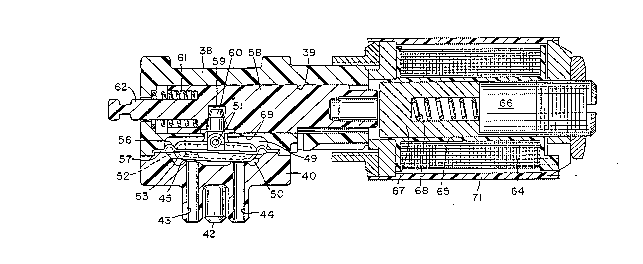Une partie des informations de ce site Web a été fournie par des sources externes. Le gouvernement du Canada n'assume aucune responsabilité concernant la précision, l'actualité ou la fiabilité des informations fournies par les sources externes. Les utilisateurs qui désirent employer cette information devraient consulter directement la source des informations. Le contenu fourni par les sources externes n'est pas assujetti aux exigences sur les langues officielles, la protection des renseignements personnels et l'accessibilité.
L'apparition de différences dans le texte et l'image des Revendications et de l'Abrégé dépend du moment auquel le document est publié. Les textes des Revendications et de l'Abrégé sont affichés :
| (12) Demande de brevet: | (11) CA 2092686 |
|---|---|
| (54) Titre français: | ROBINET ET ORGANE DE COMMANDE CORRESPONDANT |
| (54) Titre anglais: | VALVE AND OPERATOR THEREFOR |
| Statut: | Réputée abandonnée et au-delà du délai pour le rétablissement - en attente de la réponse à l’avis de communication rejetée |
| (51) Classification internationale des brevets (CIB): |
|
|---|---|
| (72) Inventeurs : |
|
| (73) Titulaires : |
|
| (71) Demandeurs : |
|
| (74) Agent: | AVENTUM IP LAW LLP |
| (74) Co-agent: | |
| (45) Délivré: | |
| (22) Date de dépôt: | 1993-03-12 |
| (41) Mise à la disponibilité du public: | 1993-09-19 |
| Licence disponible: | S.O. |
| Cédé au domaine public: | S.O. |
| (25) Langue des documents déposés: | Anglais |
| Traité de coopération en matière de brevets (PCT): | Non |
|---|
| (30) Données de priorité de la demande: | ||||||
|---|---|---|---|---|---|---|
|
VALVE AND OPERATOR THEREFOR
Abstract of the Disclosure
A valve including a valve member having two different stable
positions, and a valve operator for shifting the valve member
between its two stable positions and holding the valve member in
those positions. The valve operator includes a shuttle moveable
between two extreme positions corresponding to the two stable
positions, respectively, of the valve member. A first spring urges
the shuttle toward one of its extreme positions and a second
spring, stronger than the first spring, urges the shuttle toward
the other of its extreme positions, these movements of the shuttle
being transmitted to the valve member. A device, such as an
electric solenoid, selectively renders the second spring
ineffective with respect to the shuttle, so that when the second
spring is ineffective the first spring causes the valve member to
assume one of its stable positions, and when the second spring is
not ineffective, the second spring causes the valve member to
assume the other of its stable positions.
Note : Les revendications sont présentées dans la langue officielle dans laquelle elles ont été soumises.
Note : Les descriptions sont présentées dans la langue officielle dans laquelle elles ont été soumises.

2024-08-01 : Dans le cadre de la transition vers les Brevets de nouvelle génération (BNG), la base de données sur les brevets canadiens (BDBC) contient désormais un Historique d'événement plus détaillé, qui reproduit le Journal des événements de notre nouvelle solution interne.
Veuillez noter que les événements débutant par « Inactive : » se réfèrent à des événements qui ne sont plus utilisés dans notre nouvelle solution interne.
Pour une meilleure compréhension de l'état de la demande ou brevet qui figure sur cette page, la rubrique Mise en garde , et les descriptions de Brevet , Historique d'événement , Taxes périodiques et Historique des paiements devraient être consultées.
| Description | Date |
|---|---|
| Inactive : Demande ad hoc documentée | 2018-06-06 |
| Exigences relatives à la nomination d'un agent - jugée conforme | 2018-05-18 |
| Exigences relatives à la révocation de la nomination d'un agent - jugée conforme | 2018-05-18 |
| Inactive : CIB de MCD | 2006-03-11 |
| Demande non rétablie avant l'échéance | 2000-03-13 |
| Le délai pour l'annulation est expiré | 2000-03-13 |
| Réputée abandonnée - omission de répondre à un avis sur les taxes pour le maintien en état | 1999-03-12 |
| Demande publiée (accessible au public) | 1993-09-19 |
| Date d'abandonnement | Raison | Date de rétablissement |
|---|---|---|
| 1999-03-12 |
Le dernier paiement a été reçu le 1998-03-10
Avis : Si le paiement en totalité n'a pas été reçu au plus tard à la date indiquée, une taxe supplémentaire peut être imposée, soit une des taxes suivantes :
Veuillez vous référer à la page web des taxes sur les brevets de l'OPIC pour voir tous les montants actuels des taxes.
| Type de taxes | Anniversaire | Échéance | Date payée |
|---|---|---|---|
| TM (demande, 5e anniv.) - générale | 05 | 1998-03-12 | 1998-03-10 |
Les titulaires actuels et antérieures au dossier sont affichés en ordre alphabétique.
| Titulaires actuels au dossier |
|---|
| AUTOMATIC SWITCH COMPANY |
| Titulaires antérieures au dossier |
|---|
| JOSEPH W. BAKER |